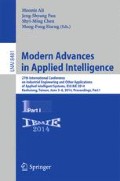Abstract
Data domain description or one-class classification concerns the characterization of a data set. A good description covers all target data but includes no superfluous space. The boundary of a dataset can be used to detect novel data or outliers. One-class classification is important in many applications where one of the classes is characterized well, while no measurements are available for the other class. Tax et al. first introduced a method of adapting the support vector machine (SVM) methodology to the one-class classification problem, called support vector data description (SVDD). In this paper, we incorporate the concept of fuzzy set theory into the SVDD. We apply a fuzzy membership to each input point and reformulate the SVDD such that different input points can make different contributions to the learning of decision surface. Besides, the parameters to be identified in SVDD, such as the components within the spherical center vector and the radius, are fuzzy numbers. This integration preserves the benefits of SVM learning theory and fuzzy set theory, where the SVM learning theory characterizes the properties of learning machines which enable them to effectively generalize the unseen data and the fuzzy set theory might be very useful for finding a fuzzy structure in an evaluation system.
Access this chapter
Tax calculation will be finalised at checkout
Purchases are for personal use only
Preview
Unable to display preview. Download preview PDF.
References
Yager, R.R.: On solving fuzzy mathematical relationships. Inform. Contr. 41, 29–55 (1979)
Zadeh, L.A.: The concept of linguistic variable and its application to approximate reasoning—I. Inform. Sci. 8, 199–249 (1975)
Guyon, B.B., Vapnik, V.: Automatic capacity tuning of very large VC-dimension classifier. Advances in Neural Information Processing Systems 5, 147–155 (1993)
Vapnik, V.N.: The Nature of Statistical Learning Theory. Springer, New York (1995)
Cortes, C., Vapnik, V.N.: Support vector network. Machine Learning 20, 1–25 (1995)
Moya, M.R., Koch, M.W., Hostetler, L.D.: One-class classifier networks for target recognition applications. In: Proceedings of World Congress on Neural Networks, Portland, OR, pp. 797–801. International Neural Network Society (1993)
Manevitz, L.M., Yousef, M.: One-class SVMs for document classification. Journal of Machine Learning Research 2, 139–154 (2001)
Tax, D.M.J., Duin, R.P.W.: Support vector domain description. Pattern Recognition Letters 20, 1191–1199 (1999)
Tax, D.M.J., Duin, R.P.W.: Support vector data description. Machine Learning 54, 45–66 (2004)
Vapnik, V.N.: Statistical Learning Theory. Wiley (1998)
Schölkopf, B., Platt, J.C., Shawe-Taylor, J., Smola, A.J., Williamson, R.C.: Estimating the support of a high-dimensional distribution. Neural Computation 13, 1443–1471 (2001)
Klir, G.J., Yuan, B.: Fuzzy Sets and Fuzzy Logic: Theory and Applications. Prentice-Hall, New Jersey (1995)
Hull, J.J.: A database for handwritten text recognition research. IEEE Trans. on Pattern Analysis and Machine Intelligence 16, 550–554 (1994)
Chiang, J.-H., Gader, P.: Recognition of handprinted numerals in VISA card application forms. Machine Vision and Applications 10, 144–149 (1997)
Gader, P., Mohamed, M., Chiang, J.-H.: Handwritten word recognition with character and inter-character neural networks. IEEE Trans. on Systems, Man, and Cybernetics 27(1), 158–164 (1997)
Author information
Authors and Affiliations
Editor information
Editors and Affiliations
Rights and permissions
Copyright information
© 2014 Springer International Publishing Switzerland
About this paper
Cite this paper
Hao, PY. (2014). A New Fuzzy Support Vector Data Description Machine. In: Ali, M., Pan, JS., Chen, SM., Horng, MF. (eds) Modern Advances in Applied Intelligence. IEA/AIE 2014. Lecture Notes in Computer Science(), vol 8481. Springer, Cham. https://doi.org/10.1007/978-3-319-07455-9_13
Download citation
DOI: https://doi.org/10.1007/978-3-319-07455-9_13
Publisher Name: Springer, Cham
Print ISBN: 978-3-319-07454-2
Online ISBN: 978-3-319-07455-9
eBook Packages: Computer ScienceComputer Science (R0)

